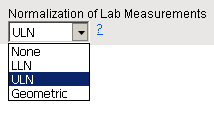Normalization of Lab Measurements
Use the drop-down menu to select a normalization to be applied to the baseline and on-therapy measurements.

Available normalizations are described in the following table:
|
Normalization |
Definition |
|
None |
Choose this option to apply no normalization to the laboratory measurements. |
|
LLN |
Select this option to divide the measured lab values by the value considered to be the lower limit of the normal range (LLN) of values. This measure normalizes the labs relative to the LLN. Values less than one are considered below normal. |
|
ULN |
Select this option to divide the measured lab values by the value considered to be the upper limit of the normal range (ULN) of values. This measure normalizes the labs relative to the ULN. Values greater than one are considered above normal. This option is specified by default. |
|
Geometric |
Select this option to normalize the data using the formula: normalized value = (log(x) - log(GM))/log(GSD), where x is the raw value, GM is the geometric mean of the upper limit of the normal range (ULN) of values and the lower limit of the normal range (LLN) of values, and GSD is the geometric standard deviation of the ULN and LLN. The geometric normalized data are measured on a scale (centered on 0) based on the number of GSD units the observations are from GM. On this scale the GM is the midpoint between the log transformed upper and lower limits (ULN and LLN) and each GSD is equal to half the range between the log(ULN) and log(LLN). With this normalization, values -1 and 1 are set to equal the LLN and ULN respectively and behave similar to a z-score. Clinically, values greater than 1 (or less than -1) can be interpreted as a measure of how far away the finding was from the ULN (or LLN) with respect to the normal range of values (ULN - LLN). Values less than 1 or greater than -1 would indicate that the finding was within the normal range of values. |
To Specify the Normalization to Apply to the Laboratory Measurements:
| 8 | Make a selection using the drop-down menu. |